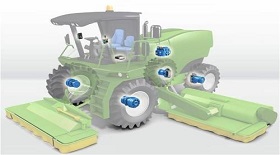Hydraulic motor control principle
Hydraulic Exhibition will open. Let us learn about hydraulic motor.
During the period of steam turbine preheating and cooling, after a relatively short period of time, the temperature difference will increase and the rotor will bend due to different thermal expansion, which will lead to the relative deviation of the center of gravity of the rotor from the center of rotation and increase the vibration of the unit when it runs again. Therefore, in order to reduce the bending of the rotor caused by thermal expansion, it is necessary to drive the rotor to rotate at a lower speed through the turning device.
Hydraulic disc is driven by the loss of power of solenoid valve, which makes one-way valve open. The top axle oil enters the oil inlet of the hydraulic motor through the oil disc, and enters the motor through the distribution of the oil disc, which generates thrust F at the bottom of two or three pistons. F can be decomposed into two forces, one is the connecting O1 side along the crankshaft rotation center O and the eccentric wheel center O1. The directional force Fr and the tangential force Ft perpendicular to the connecting line OO1 will produce a moment to the rotation center O of the eccentric crankshaft to make the crankshaft rotate. Although the moments produced by each piston are different in size, they are in the same direction, and the sum of these moments drives the output shaft to rotate and work, and the other three or two pistons will rotate. Then, the oil in the plunger cylinder is pushed back to the oil tank through the oil distributor. In each work cycle, the piston cylinder chambers are connected in turn to enter and return oil. Because the relative position of the oil distribution plate and eccentric crankshaft is unchanged, there are always two or three pistons connected with the oil intake port of the oil distribution plate at any time, and the direction of the moment generated by the rotation center of the eccentric shaft is unchanged, ensuring that the motor drives the steam turbine. When it is necessary to stop the turning, the solenoid valve of the turning is charged, and the one-way valve is closed under the action of spring force, cutting off the top axle oil supplied to the turning and stopping the turning.



